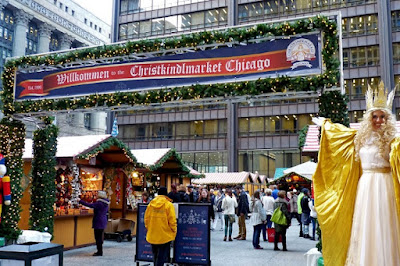As the daylight turns from growing to waning at the end of September, there is a different kind of light to distract the masses from the darkness. One can already see the signs of Christmas in the department stores on State Street. Christmas lights, candles, wreathes and bows appear in the store overnight on some unnamed date during September. Quietly, ornaments, clothes and gift baskets appear even before Halloween has been celebrated. Along with the change in merchandise, Chicago’s State Street transforms into a holiday culture that thrives on the consumption of an idea, “the holiday season.”
Multitudes of shoppers make their way into the shopping district that is bound between Michigan and Dearborn Avenues on the east and west and Randolph and Balbo Avenues on the north and south. The city of Chicago and the surrounding businesses transform this area into a virtual theme park centered around the idea of Christmas. Windows of department stores are full of storybook images that display towns and village life that urban shoppers have never known, but want to imagine themselves having been a part of. There are decorated streetlights, jingle bells and bows to make the streetwalkers all feel they are in a magical place. All of this is centered around a German market and an ice-skating rink.
Although most of the shoppers are not German and many are not religious, they are still taking part in the mass consumption that industrial capitalism has produced: ornaments, decorations, food, presents, gift wrap and cards. Shoppers are convinced that giving is a way to show you care and the best gifts are those refined items for purchase in the various stores throughout the shopping district. It might include one of any hundreds of Christmas ornaments, or a prepackaged, pre-assorted gift basket. In an authentic culture, these consumers would be giving far more meaningful and personalized gifts. They would not buy a basket at Marshall Field’s full of mass produced culture such as candy-canes, fruitcake, Frango mints, holiday-blend coffee, hot cocoa, etc. Instead, these consumers would be producers; each might be at home baking something from a family recipe that has been perfected and passed down over generations. Then, the producer might package and decorate the basket in a meaningful and unique way and deliver it to their loved one’s open-arms personally.
Instead, the would-be consumers must participate in this seasonal, generic culture. They enjoy shopping at the German market. Although the majority are not German, they enjoy purchasing German blown-glass, drinking grog and eating roasted chestnuts - items that cannot be easily found the rest of the year in Chicago.
These consumers make purchases based on mass media’s promotion of the latest and most festive holiday clothing, decorations, and gift ideas. One example of this marketing is from a season or two ago when the Gap, a major retailer in the state street shopping district, demanded, “Everybody in leather.” The creation of this inauthentic culture is not limited to Chicago’s State Street. This is just one example. Malls and shopping districts all across America promote this suspension of reality to sell their mass produced items for the “holiday season.” When the Gap says, “Everybody in leather,” they really mean everybody - everybody in America, whether you celebrate Christmas or not, whether you are on State Street or in the Mall of America.

No comments:
Post a Comment